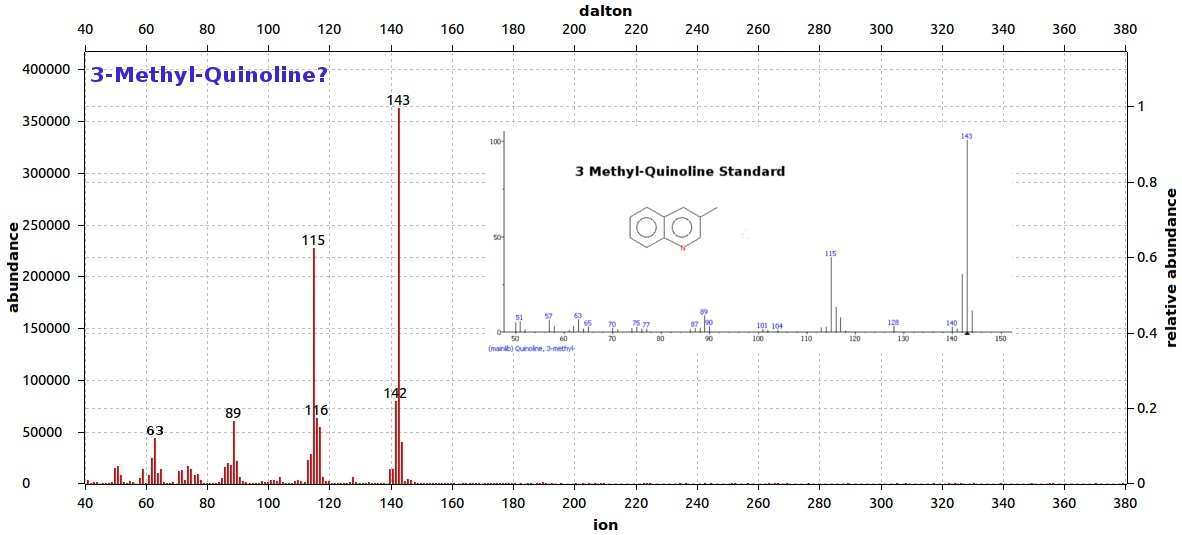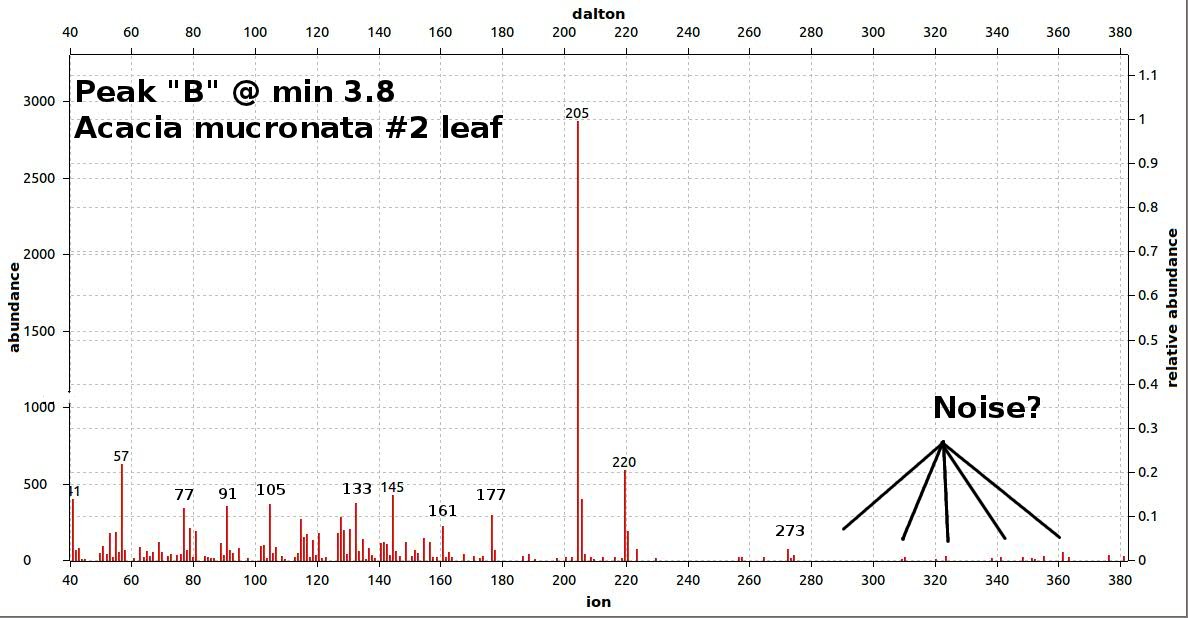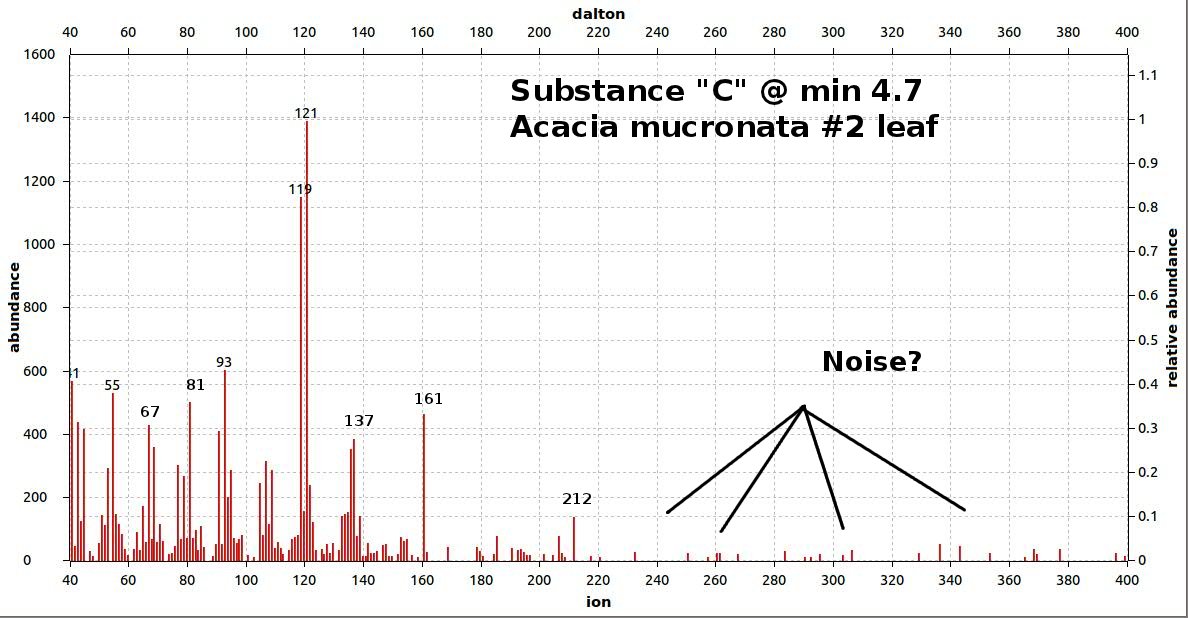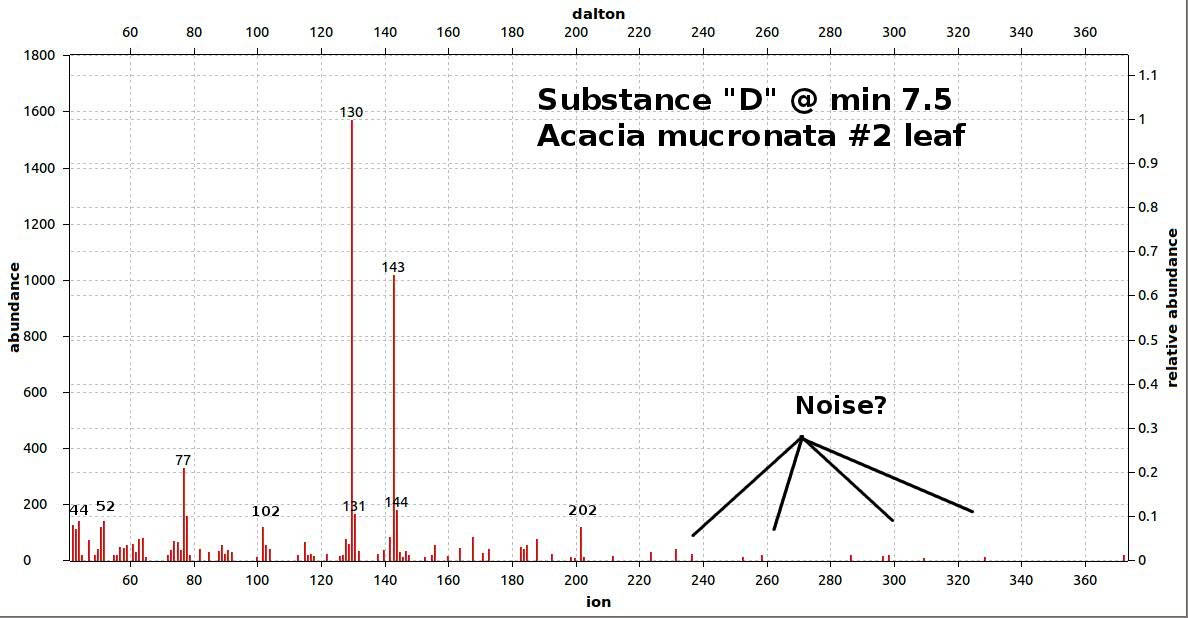member for the trees
  
Posts: 4003 Joined: 28-Jun-2011 Last visit: 27-May-2024
|
..a little more on the acacia extraction methodologies, which may also help explain the color differences..
I'm very surprised there is no NMT in that obtusifolia sample...it's a tricky species i guess..but it's usually in there, from past tests..i unfortunately don't have the Southern Cross University GCMS chart from a test c 2000 anymore...
..the obtusifolia leaf (phyllode) and trunk bark samples were from the same tree and time as the twig..they were extracted very quickly from small amounts..3 X 30min boiling in water/ethanol/vingegar..basified with NaOH..extracted with DCM..2 hours approx followed by 1-2 hour solvent evaporation with fan...the bark was washed just once with basic H20, the leaf was crude..this was also how the acuminata leaf was done (quickly)
..the obtusifolia twig, and ob. X maidenii twig+leaf were extracted very meticulously over a few days (same materials, higher ethanol ratio), including careful filtereing several times of particulate matter..the solvent was washed with salty basic H2O several times..it was re-crystalized very slowly over several days, allowing purer crystals to form..in such careful process NMT will also crystalize, just wasn't any in this sample..
[afternote: no one should touch these species in the wild, where they're becoming more vulnerable...only very small amounts of material are involved in these tests, and recent tests are now all based around cultivated material]
|
|
|
|
|
DMT-Nexus member
Posts: 1104 Joined: 17-May-2009 Last visit: 18-Jul-2023
|
Amazing thread!
Could whoever is doing these wonderfull analysises next time maybe meisure
the percentages of DMT & it's analogues in relation to the weight of the
plant material it was extracted from? It would be great to have more
measurements of DMT contents in percentages to get a more accurate average
of the DMT content of these various species of Acacias' Roots, Bark, Leaves,
Fruits, Seeds & Flowers, harvested during different times of the same Day/Week/
Month/Year.
This way we could get a clearer idea of what parts of particulair acacia species,
(root,bark,leaf,seed or flower) are generally the richest in DMT and at which
particulair time of the Day/Week/Month/Year this part of the plant itself is most
rich in DMT.
|
|
|
member for the trees
  
Posts: 4003 Joined: 28-Jun-2011 Last visit: 27-May-2024
|
..approximate for each (in tested examples)
acuminata leaf 1.2% alkaloid (winter);
obtusifolia leaf 0.4-0.5%, twig 0.6-0.7%, bark 0.6% (late summer);
obtusifolia X maidenii leaf & twig (combined) (autumn/fall) 0.6-0.7%
|
|
|

DMT-Nexus member

Posts: 14191 Joined: 19-Feb-2008 Last visit: 22-Nov-2025 Location: Jungle
|
So the acacia obtusifolia leaf and bark, harvested and extracted in the conditions mentioned above, both are mostly DMT (around 80%+). Both also show a small amount of 2MTHBC and this alkaloid which we previously 'guessed' as 3-methyl-quinoline, but this deserves more investigation (is this alkaloid described in acacias? etc)
I will update earlier posts in this thread to add the results of the obtusifolia leaf and bark, mass spectra and all, this weekend
|
|
|
member for the trees
  
Posts: 4003 Joined: 28-Jun-2011 Last visit: 27-May-2024
|
..you might have finally found the long rumored 'alkaloid X' of obtusifolia..it generally just doesn't usually behave like some other dmt source plants (even without the NMT) ..
i better get into NIST or openchrom ..thanks for all the work so far endlessness..
.
|
|
|

DMT-Nexus member

Posts: 14191 Joined: 19-Feb-2008 Last visit: 22-Nov-2025 Location: Jungle
|
There seems to be very small amounts of NMT in the obtusifolia, it co-chromatographs with DMT in our system, but if its in high amounts one can see distinct peak, so it leads to me believe there is only small amount, maybe 1%. By the way, I edited the post #16 in the last page to include the nicely visual GC-MS results of the acacias. I also added their raw .MS file to the ZIP file attached to that post. And as for the 3-Methyl-Quinoline possible identification, here's it's mass spectra, next to from a standard (right click and "view image" for bigger size). 
|
|
|
member for the trees
  
Posts: 4003 Joined: 28-Jun-2011 Last visit: 27-May-2024
|
..the plot is really thickening with this 3-methylquinoline A. obtusifolia substance (and the mass spec data is pretty close) ..curiously it is found in various species of proteobacteria, including a sludge/shale dwelling species Comamonas testosteroni 63.. from Biol Chem Hoppe Seyler. 1993 Mar;374(3):175-81."Microbial metabolism of quinoline and related compounds. XVII. Degradation of 3-methylquinoline by Comamonas testosteroni 63."Schach S, Schwarz G, Fetzner S, Lingens F.; Institut für Mikrobiologie, Universität Hohenheim, Germany.Quote:A bacterial strain which utilizes 3-methylquinoline as sole source of carbon, nitrogen and energy was isolated from activated sludge. On the basis of its morphological and physiological characteristics, this isolate was classified as Comamonas testosteroni. Four metabolites of 3-methylquinoline degradation were isolated from the culture supernatant and identified as 3-methyl-2-oxo-1,2-dihydroquinoline, 6-hydroxy-3-methyl-2-oxo-1,2-dihydroquinoline, 5,6-dihydroxy-3-methyl-2-oxo-1,2-dihydroquinoline and 2,5,6-trihydroxy-3-methylpyridine. ..could this compound have a microbiological origin..how would the plant synthesise it? it occurs in traces in tobacco and cannabis smoke..quinolines occur naturally in coal tar.. Quote: In tests run on a nitrogen-containing shale oil fraction, Pseudomonas [bacteria] species hydroxylated the 2-position of
3-methylquinoline (Aislabie et al., 1990) ..and there is conflicting evidence regarding toxicity, but the Product Safety Data sheet of a supplier of 3-methylquinoline says that there is no known carcinogenic activity, but no available information on acute toxicity.. it is claimed to irritate eyes and respitory systems..there is 1 +ve report of mutagenic activity in rat liver, and a few negative.. ..however, in the amounts present in the extract tested by endlessness, there is no evidence of any kind of toxicity.. the extracts, however, do behave slightly differently to pure DMT (particularly the onset) which could also be due to the small amounts of ß-carboline.. . ps. the liquid fraction of the leaves of A. acuminata, when reduced by boiling down, emitted a high-pitched squeal similar to certain ayahuasca brews being boiled down..in the amazon it is said to be a good sign when the brew 'sings' like this..these particular leaves are orally active on their own..a spirit to be respected indeed...
|
|
|
member for the trees
  
Posts: 4003 Joined: 28-Jun-2011 Last visit: 27-May-2024
|
..here's two handy charts by Trout 2003.. molecular weights of indoles and betacarbolines found in acacias... nen888 attached the following image(s):  acacia indole mol weights.jpg (59kb) downloaded 1,092 time(s). acacia betacarboline mol weights.jpg (46kb) downloaded 1,091 time(s).
|
|
|

Sifu
Posts: 81 Joined: 03-Jan-2011 Last visit: 27-Jul-2014 Location: doorways
|
Endlessness - absolutely friggin awesome work.... I was going to post a Q - then I found this thread... I'll still post a Q - I was wondering, is it worth including season of harvest for the yeilds - to see the variance?
|
|
|

DMT-Nexus member

Posts: 14191 Joined: 19-Feb-2008 Last visit: 22-Nov-2025 Location: Jungle
|
Thanks  The harvest season, extraction method and yields were in nen's posts but I edited so they are mentioned now in first post. Nen, very handy chart! The extracts will be analysed again with HPLC-MS sometime in the future, where mass weight of the substances can be seen better.. Ill be sure to post the results 
|
|
|

DMT-Nexus member
Posts: 43 Joined: 06-Oct-2011 Last visit: 06-Mar-2022 Location: Melbz
|
Fantastic work guys. So wonderful to see data on Acacia species coming out like this. Absolutley fascinating reading. Keep the good work going.  "You don‘t have a soul. You ARE a soul. You have a body." —C.W. Lewis
|
|
|
member for the trees
  
Posts: 4003 Joined: 28-Jun-2011 Last visit: 27-May-2024
|
..thanks again for this great testing work endlessness..  , and all the other analysis threads..what an achievement for the Nexus as an information resource..! can't wait for the next round.. ..for reference i'm attaching the original Acacia maidenii phytochemical paper: Alkaloids Of The Australian Leguminosae: The Occurrence Of Methylated Tryptamines In Acacia Maidenii F. .Muell. By J. S. Fitzgerald and A. A. Sioumis, Aust. Journal Chemistry 1965..they found 0.6% NMT/DMT 2:3 in bark.. i thought it interesting that with their system: Quote:Gas chromatography of the crude base in a column at 203º with Silicone E-301 as stationary phase gave a single peak, but it was found later that this phase did not separate mono-and di-methyltryptamines ..this sounds similar to the current GCMS system being used..the authors ended up using chromatography on alumina to separate the two tryptamines..i'm curious what Gas Chromatograph system/phase will show clear peaks of these two close tryptamines.. at least i know, from conversation with endlessness, that future NMR tests can clear up how much (if any) NMT is present in the samples.. ..also of interest from the paper..NMT (as the base) Quote:..eluted from the alumina column crystallized from light petroleum in white prisms, m.p. 86-87º (lit. m.p. 89º ) Picrate, red needles, m.p. 193-195º (lit. m.p. 190º ) DMT (as the base) was Quote:..crystallized from hexane and initially had m.p. 48-41º. A solution seeded with an authentic sample of NN-dimethyltryptamine had m.p. 57.5-58.5º..Picrate, m.p. 170-171º (lit. m.p. 170º ) . The picrate prepared in ethanol solution separated as red crystals but on recrystallization a mixture of red and yellow crystals was produced, the red crystals melting at 171-171.5º, and the yellow ones at 170-171º. On further recrystallization only the yellow form was obtained. ..the many colors of dmt..? or trace ß-carboline 'impurities'? also, i wonder what their white NMT prisms looked like a few weeks later..both Shulgin and my experiments found NMT to darken very rapidly with time..'circular prisms' or needles is the usual NMT crystal form.. .
|
|
|

DMT-Nexus member

Posts: 14191 Joined: 19-Feb-2008 Last visit: 22-Nov-2025 Location: Jungle
|
I added new results to the first post, Mucronata #2, Acuminata #2 and Obtusifolia #2. One mucronata stem result missing (though seems very similar to leaf), Ill have to send it to test again due to some concentration issues. As always, percentages are approx only.
Nen, regarding NMT, notice how interesting this mucronata has no DMT but plenty of NMT. Regarding finding ratio of NMT to DMT in other samples, this will be done with LC-MS hopefully this summer, not with NMR which unfortunately I have no access to. Thanks for the paper btw
Later we can talk about the other unknowns in the above images. BTW, I was very surprised with harmine ! It was not contamination on my part for sure. Later looking at Trout's table and it mentions harmine found in Acacias and related plants. Do you know which Acacias were found with harmine?
|
|
|
member for the trees
  
Posts: 4003 Joined: 28-Jun-2011 Last visit: 27-May-2024
|
..wow! i intuitively felt there was something special about that mucronata..i'd actually have dreams about the plant.. the only reference i can find to regarding what i think Trout is talking about is Oliver-Bever reports 'harmane derivatives' (and tryptamine) in the african A. nilotica [ Medicinal Plants in Tropical West Africa 1988]..depending on what 'derivatives' means, 'harmane' is a synonym for harman..previously in obtusifolia, N-methyl-tetrahydroharman (leptocladine), and norharman were reported.. ..so, this is, as far as i know, the first time Harmine has been found in an Acacia species..!  the phyllodes (leaf) and twig of an Acacia mucronata var. longifolia (grown from seed from northern Victoria, Australia) were picked from quite young plants, about 6-8 months old from seed..i suspected the alkaloid profile may be different to the mature adult parents (which, from commissioned GCMS contained DMT, NMT, tryptamine and unidentified at the time betacarbolines; see S. Voogelbreinder "Garden Of Eden" 2009, and https://www.dmt-nexus.me/forum/d...m=254551&#post254551 )..they were extracted with ethanol/methanol/H20 70:5:25, concentrated under acetic acid, basified with NaOH, and extracted with dichloromethane, and left in crude form without re-crystalization..despite no dmt, a single bioasay by vapor several years ago of about 50-60mg displayed noticeable effects, though not hugely visual or colorful..yield was around 0.3-0.4%.. ..the phyllodes of Acacia acuminata Narrow Leaf variety were collected Feb. roadside and extracted by a friend, using acetic acid/ethanol 50:50, NaOH, xylene..the percentage was 0.9-1.0%, a very high % for the leaf of any plant (though phyllodes are technically extensions of the petiole, which is twig bark) ..the branch bark (of this specimen) is apparently 1.5% approx. fantastic, and interesting as always, results endlessness..thank you..!  . ps. gotta look into this 3-methyl-quinoline ( A. obtusifolia) thing more..is this plant derived, or from symbiotic micro-organisms, or even mineral..? very curious.. .
|
|
|

DMT-Nexus member
 
Posts: 12340 Joined: 12-Nov-2008 Last visit: 02-Apr-2023 Location: pacific
|
the narrow phyllode acuminata looks very clean..I bet it would be similar to psychotria in brews..cant wait till mine are large enough to harvest a little bit. Long live the unwoke.
|
|
|

DMT-Nexus member

Posts: 14191 Joined: 19-Feb-2008 Last visit: 22-Nov-2025 Location: Jungle
|
Thanks for the post nen! So I wonder why did Trout add harmine to that table saying "found in acacia and related species" if it was never found in acacia.... ? Also notice the obtusifolia also has harmine. Again, the contamination is NOT on my part, can it be in the part of the person extracting, or are we really finding some very interesting new info now??  Im attaching the TLC plate, which I had done with a different part of the sample and it indeed shows the harmine. Sorry its a bit messy, but yeah the acuminata is the only that does not show any harmine, of those 4 samples. The mucronatas might have very small amount of DMT, I tried circling what could have been DMT there, but in the GC-MS since NMT was overwhelmingly more present, if there was DMT it doesnt show in our system. Again, in the future with LC-MS this will be re-tested. Ill get back to these last results to talk about the "unknowns" maybe tomorrow or during the weekend, there's another possible tryptamine-based substance there in small amounts. endlessness attached the following image(s):  plate.jpg (581kb) downloaded 932 time(s).
|
|
|
member for the trees
  
Posts: 4003 Joined: 28-Jun-2011 Last visit: 27-May-2024
|
..thanks for the pics endlessness, regarding Harmine, i've checked through Trout's entire alkaloid lists in his 2003-4 acacia revision [ http://www.largelyaccurateinfor..._Acacia_revision2004.pdf] and can find no reference..i recall a conversation years ago in which he commented it 'might' be in some acacias based on other beta carbolines, but if it had been found it would have been big news (especially downunder) ..i will contact Trout in the near future to double check, and say hi cause he's a truly nice person.. it's an interesting synchronicity that the provided obtusifolia sample also has some..it was from a variety with more pointy phyllodes than the norm, and there can't have been contamination on my part as the extractions are from different years, and at neither point was i extracting caapi or bringing such things nearby..as with these tests, only small quantities of material were extracted.. always full of surprises, Acacias..  .. jamie wrote: Quote:the narrow phyllode acuminata looks very clean..I bet it would be similar to psychotria in brews..cant wait till mine are large enough to harvest a little bit. ..i've seen profiles of P. viridis which have more 2MeTHBC than this particular acuminata..one specimen of P. viridis tested as mainly NMT, interestingly, according to Trout's notes..also, in comparison with P.virdis, the narrow-leaf acuminata has 3 times the amount ..  ..what remains to be studied more is just how fast it can be grown in cultivation..most acacias, with help and love, can get to 5-6ft in 3-5 years.. .
|
|
|
member for the trees
  
Posts: 4003 Joined: 28-Jun-2011 Last visit: 27-May-2024
|
..one more bit of potentially relevant info, to do with the young age of the A. mucronata plants tested (c.6 months)
at the 2009 EGA conference near Melbourne, Australia, acacia phytochemical researcher 'J.J.' mentioned that he had tested young Acacia phlebophylla plants..the phyllodes contained almost entirely simple Tryptamine, around 0.2%, and some betacarbolines..
it was quite mature adult plants which yielded 0.3% DMT in the phyllodes..
..so both these examples suggest DMT is an alkaloid which comes with maturity in some acacia species..
.
|
|
|
member for the trees
  
Posts: 4003 Joined: 28-Jun-2011 Last visit: 27-May-2024
|
..ps. is that a trace of possible 5meoDMT in the obtusifolia#2 TLC plate..? 5meo has been reported at leastb once as a lesser component of obtusifolia alkaloids.. pps. been informed ethanol/vinegar soak used in acuminata Narrow leaf extract.. in looking for explanations for the synchronous Harmine findings, there are one thing in common about the two extracts (mucronata & obtusifolia#2), which is they are not recent..in fact both were actually done 5-7 years ago..i'd kept these small samples as interesting for possible testing.. ..so, back to the Harmine, the other thing the samples have in common is that they were given a lot of heat/prolonged boiling in ethanol/acetic acid/H20..i've since toned down the temperature and acidity of extractions (such as the earlier tested samples) we have multiple and fairly common findings of betacarbolines like harman, tetrahydroharman, norharman & 2MeTHBC in Acacias.. so, my question is (to the chemically minded) could Harman-type or THBC betacarbolines be converted/degraded into Harmine (or Harmaline) by prolonged boiling, acidity or time..? this question relates also to these threads: https://www.dmt-nexus.me/forum/d...aspx?g=posts&t=31699& https://www.dmt-nexus.me/forum/d...osts&t=28535&p=1.. but that said, the mucronata extract looked unchanged after quite a few years..i do think the Harmine was in there to begin with..it seemed different to acacia extracts previously seen..the betacarb aspect of the adult parent extract seemed different too.. .
|
|
|

DMT-Nexus member

Posts: 14191 Joined: 19-Feb-2008 Last visit: 22-Nov-2025 Location: Jungle
|
Nen, very interesting regarding DMT probably appearing on later on during the growth ! re: the possible 5-Meo-DMT in obtusifolia there, nope it's just related to the concentration of DMT that it is in a bit different height.. I didn't post the picture but later I used some PDMAB-TS which makes 5-MeO-DMT clearly green while DMT stays yellow, and there was no sign of green. Also in the GC-MS the unknown substance is not 5-MeO-DMT. I'll post the mass spectra later. Anyways here is the mass spectra of the 3 main "unknowns" in mucronata, so maybe others can try to find what it is; EDIT: Substance B and D have been identified. Read post further down or reload the first page for new version of spectra image    It's a bit hard to know what's the mass peak there because there is some noise (here a LC-MS would come in very hand to know the exact mass weight of the substances, but this will take a couple of months still). But from the looks, I think it could be that the weight of B is 220 (or 273), of C is 212 and of D is 202 (also appears as "peak E" in acacia acuminata in first page). From looking at Trout's list of substances nen posted above, it would be worth trying to find the mass spectra of N,N-formyl,methyl-tryptamine, 5-Hydroxy-DMT-N-oxide and 6-methoxy-1,2,3,4-tetrahydro-B-carboline, see if any of them match. Edit: Regarding substance D, the paper we need is: Poupat et al. (1976) Phytochemistry 15: 2019-2020. [Christiane Poupat, Alain Ahond and Thierry Sévenet] "Alcaloides de Acacia simplicifolia." Hopefully the mass spectra is there. In this paper they mention the nn,formylmethyltryptamine in an Acacia, which might be substance D n mucronata and E in acuminata (and I think i've seen it other times too, Ill have to check back on the mass spectra of other plants ive tested so far). In TIHKAL NMT page, the synthesis uses formyltryptamine, and he mentions the mass spectra having main peaks 130 and 143, like substance D, which might be good indication.
|